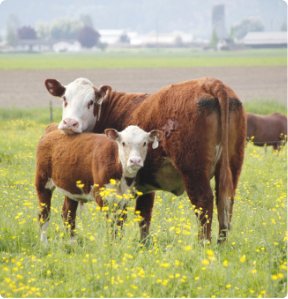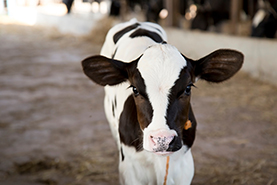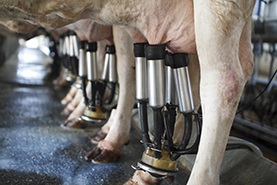

Sustainable Production
Sustainability in cattle production includes elements such as:
- Maximizing grass in the diet
- Improved genetic rating of the herd
- Managing the herd to achieve its genetic potential
- Ensuring animals remain healthy through appropriate herd health protocols
Sustainable dairy production must1:
- Be economically profitable
- Produce high-quality milk
- Maintain the optimal wellbeing of cows
- Consider the environment and consumers

The Environmental Impact of Replacement Dairy Heifers on Sustainability and Longevity
Target age at first calving (AFC) is 24 months because2:
- Heifers that first calve at 24 months produce more milk during their lifetime
- Have a shorter non-productive period
- Maintains a seasonal calving pattern

Cows that calve younger
have good fertility and survive longer to calve a second or third time3.
Nutrition and management:
In general, an average daily gain of around 0.80 kg is optimal for dairy heifers4.
- Lower rates delay puberty and raise the average first-calving age.
- Excessively high growth rates may be detrimental to fertility4.
- Late-calving heifers are also more likely to be overweight, which can cause problems during their first lactations.
Through natural mating, both the bull and the cow can encounter many different risks. Artificial Insemination (A.I.) offers a more hygienic way of breeding through sterilized equipment. With A.I., generally a producer does not need to maintain a bull all year round on their farming system. Thereby, reducing the environmental impact of the bull as well as the associated costs with maintaning a bull on-farm solely for breeding. A.I. allows producers from around the world to select the semen that is just right for their cows and their systems leading to better genetics and reducing the risk of having a bull on the farm. One bull ejaculation can make enough semen for 100 doses, or more commonly known as straws. Instead of that one ejaculation going for just one cow, it can potentially reach 100 more cows to reproduce more calves.
Production and reproduction efficiencies are strongly related to the environmental impacts of dairy or beef cattle operations.
Implementing management practices that improve production efficiency also:
- Increases milk production
- Reduces use of resources
- Mitigates environmental impact
Replacement heifers: Decreasing the AFC to 22-24 months of age and increasing the first-lactation milk yield improves productivity and decreases emissions per kilogram of fat-corrected milk (FCM).

Administration of high-quality colostrum within the first few hours of life improves long-term animal health and first-lactation performance, decreasing emissions per kilogram of FCM4.
Herd-health challenges affect per-unit of-milk emissions by:
- Increasing mortality and losses of saleable milk
- Decreasing reproductive performance and milk production efficiency

Herd-health challenges affect per-unit of-milk emissions by:
Mastitis is a herd-health challenge that can affect emissions per kilogram of FCM by decreasing milk production performance and increasing losses of saleable milk. A 2005 study5 analyzed the environmental impact of reducing the clinical and subclinical mastitis rates from 25% to 18% and 33% to 15%, respectively, in dairy herds in Galicia, Spain. This increased the input-use efficiency, decreased milk-production losses and milk waste, and reduced the global warming potential (GWP) per unit of milk by 2.5%.
Nutrition and Feed Production
- Diet composition can alter rumen fermentation to reduce CH4 and NH3 emissions.
- Managing feed to minimize waste while maximizing milk production is key.
Increasing the concentrate/fiber or concentrate/silage ratio reduces CH4 emissions in two ways:
- Directly: CH4 is mainly produced by a fiber-rich diet
- Indirectly: higher milk production per cow means fewer cows are required
- von Keyserlingk MAG, Martin NP, Kebreab E, Knowlton KF, Grant RJ, Stephenson IIM, Sniffen CJ, Harner III JP, Wright AD, and Smith SI. 2013. Invited Review:Sustainability of the US dairy industry. Journal of Dairy Science 96:5405–5425
- Wathes DC, Pollott GE, Johnson KF, Richardson H, Cooke JS. 2014. Heifer fertility and carry over consequences for life time production in dairy and beef cattle. Animal 8: s1:91-104.
- Cooke JS, Cheng Z, Bourne NE, Wathes DC. 2013. Association between growth rates, age at first calving and subsequent fertility, milk production and survival in Holstein-Friesian heifers.
- Mitloehner FM. Feed Efficiency and Sustainability of the Cattle Industry. Contemporary environmental issues. Department of Animal Science, University of California, Davis.
- Hospido A, Sonesson U. 2005. The environmental impact of mastitis: A case study of dairy herds. Science of the Total Environment. 343:71– 82.8.

